Customization to Create Standardization
How infrastructure leaders are realizing new construction projects such as data centers, renewables, and EV charging stations using an element of customization as part of their SOP (Standard Operating Procedure).
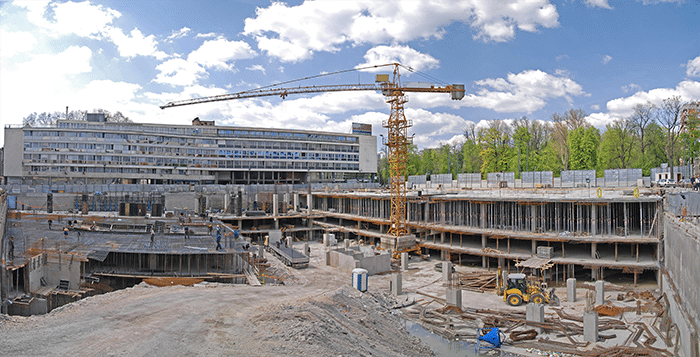
The tremendous growth of infrastructure-heavy industries, such as energy, technology, and transportation, has necessitated the construction of new facilities to meet rising consumption demands. AI, cloud computing, vehicle electrification, and renewable energy stabilization and grid integration have contributed to a massive influx of new construction projects. Data centers, Battery Energy Storage Systems (BESS) facilities, and EV charging stations are just a few primary examples that have seen a significant increase in new projects over the past few years. The design-build companies working in these sectors are under increased pressure to deliver quickly, reliably, and cost-effectively while managing a myriad of constraints such as skilled-labor shortages, supply-chain volatility, permitting and regulatory delays, and site variability.
To overcome these building challenges, many companies have turned to a surprising strategy: customized solutions as a path toward standardization. While that may sound contradictory at first, the strategy addresses the growing need for scalable, repeatable, and reliable installations—even across diverse environments. “Standardization” and “customization” may seem like conflicting approaches. In practice, the dual approach is a blend of repeatable design frameworks combined with site-specific tailored engineering. It is proving to be a winning formula for companies seeking to fast-track and streamline building processes to meet demand pressures.
| Related Content: Sealing Conduits for Resilient Electrical and Telecommunication Systems |
The Challenge of Uniformity Within Critical Infrastructure Installations
Unlike traditional construction projects, critical infrastructure installations face a complex array of variables. This is primarily attributed to the selection of the site location. New large data centers are being built on the outskirts of densely populated areas, where land availability is more cost effective. Renewables are largely built in rural areas with wide open areas that provide optimal operation for solar and wind. EV stations tend to be built in a variety of locations, from urban environments to remote highway corridors. Yet, in these examples, access to high-capacity electrical substations and fiber routes are essential. This introduces factors such as site-specific geotechnical conditions, local utility regulations, environmental constraints, and evolving technology requirements, that make rigid standardization difficult. But, without a degree of uniformity in design, companies risk longer build times, inconsistent quality, and higher lifecycle costs.
Most elements within or inside the structural footprint can be controlled, but surrounding and connecting to the site can be a mixed bag that is difficult to replicate and plan for. This is where customization plays a role.
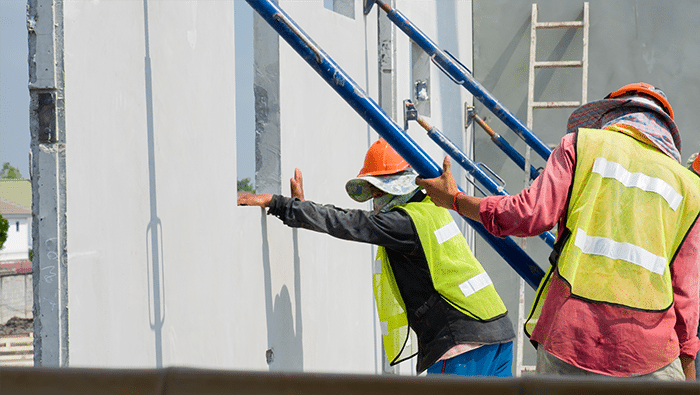
Modularization and Prefabrication: Built to Fit, Designed to Repeat
One major construction methodology that has enabled fast-tracking projects is the use of off-site manufactured components such as modular construction materials and prefabrication. From prefabricated power skids in data centers to modular cable trench systems for solar farms, organizations are investing in components that can be mass-produced yet tailored to individual sites. This approach significantly reduces on-site labor, shortens timelines, and ensures repeatable quality regardless of location.
For complex, speed-critical builds like data centers, many utilize components such as modular precast concrete walls. The precast components have advantages when it comes to quality control and construction timelines, as they enable overlapping design and construction phases. Off-site fabrication allows wall systems to be built while site work (e.g., foundation preparation, underground utilities) occurs simultaneously. Precast components are delivered ready to install, reduce on-site labor time, and enable fast enclosure of the structure’s envelope.
Prefab components can speed up aspects of the project, specifically early in the project development. The design and planning phase must be finalized early, as this impacts the specification of building components. There is little tolerance for errors, as precise site preparation and foundational work are critical to avoid project delays due to rework when prefabricated elements arrive. Yet, with potential supply chain disruptions the coordination between vendors is critical and often is a disruptive factor. Vital components can arrive out of sequence leading to potential project delays. Construction teams require an element of agility in order to navigate the uncertainties that come with supply chain issues. They lean on potential custom integration solutions from manufacturers.
| Related Product: Polywater® | Hauff-Technik® Engineered Seals |
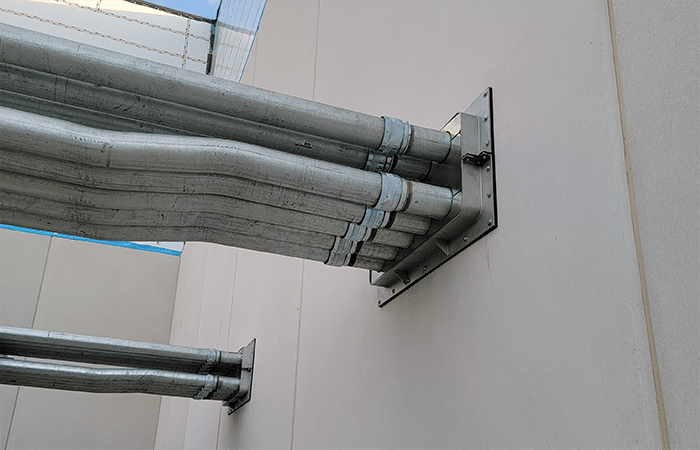
Engineered Sealing and Protection Systems — a Vital Customization Tool
An element within a construction project that is most vulnerable to complex on-site technical challenges is the sealing of wall penetrations, building entries, and inside cable conduits for utility connections. As previously mentioned, the components inside the structural footprint can be standardized, however utility connections can vary from site to site, making it difficult for engineers and planners to specify a one-size-fits-all solution across similar construction projects. This is a crucial area where customized integration solutions can play a vital role in standardizing construction processes.
Protection from environmental factors is a key concern in data centers, BESS facilities, and EV charging station construction sites. In critical applications such as data centers, a poorly sealed conduit or cable entry point can result in moisture intrusion that threatens sensitive electronics or leads to costly downtime.
In renewable energy and EV charging infrastructure, improper sealing may compromise long-term asset performance or even pose safety risks.
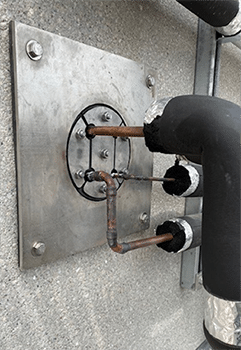 To address this, companies partner with manufacturers, like Polywater, to design site-specific sealing kits or systems that account for the exact mix of cable or pipe diameters, enclosure materials, and environmental conditions.
To address this, companies partner with manufacturers, like Polywater, to design site-specific sealing kits or systems that account for the exact mix of cable or pipe diameters, enclosure materials, and environmental conditions.
One example was the creation of a custom-designed wall sealing system to ensure a secure enclosure around several pre-installed six-inch (15 cm) GRS conduits that penetrated a data center building envelope. These conduits, critical for housing essential cabling and infrastructure, needed to be sealed effectively to protect against environmental hazards. The sealing system that was devised consisted of an innovative split flange that allowed the seal to be retrofitted easily around the pre-installed conduits, while the mechanical seals conformed to the precise openings, spacing, and outside diameters of the conduits. This bespoke approach was fabricated and installed in less than eight weeks, and the expeditious nature of the installation reduced labor costs and enabled the data center to become operational more quickly.
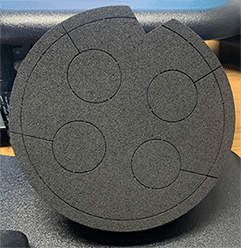 Another example of a custom seal solution for a data center involved the creation of a tailor-made foam dam template that supplemented an expanding urethane foam duct sealant kit. The situation required a series of unique tapered PVC wall sleeves—each with several mission-critical cables routed through them—to be sealed against potential environmental intrusions. The challenge was that the shape of this sleeve design created variability in the inner diameter of the duct, making a standard sealing solution so labor-intensive that it would have added impractical time and expense to the project. A fast custom solution was needed to address the already installed sleeves and cables. A custom dam was therefore created to fit the exact size and number of cables running through each sleeve, and it included a perforated outer layer that installers could remove to accommodate the smaller end of the sleeve. This approach essentially created one foam dam design that could be adapted to each sleeve opening, forming a tough water- and air-tight seal once the sealant was installed.
Another example of a custom seal solution for a data center involved the creation of a tailor-made foam dam template that supplemented an expanding urethane foam duct sealant kit. The situation required a series of unique tapered PVC wall sleeves—each with several mission-critical cables routed through them—to be sealed against potential environmental intrusions. The challenge was that the shape of this sleeve design created variability in the inner diameter of the duct, making a standard sealing solution so labor-intensive that it would have added impractical time and expense to the project. A fast custom solution was needed to address the already installed sleeves and cables. A custom dam was therefore created to fit the exact size and number of cables running through each sleeve, and it included a perforated outer layer that installers could remove to accommodate the smaller end of the sleeve. This approach essentially created one foam dam design that could be adapted to each sleeve opening, forming a tough water- and air-tight seal once the sealant was installed.
This solution went beyond preventing ingress from environmental factors. It enabled construction teams to standardize the installation of multiple sealants across multiple wall entries, which created significant efficiencies and reduced installation time.
| Related Product: Polywater® FST Expanding Foam Sealant |
In both examples, construction proceeded as planned because the design and fabrication of the customized sealant solutions fit into the construction timelines. This may have seemed counterintuitive when considering a customized solution, but with the right partner, project setbacks were avoided. Furthermore, these systems were tested and certified to meet stringent IP, IEC, NEMA, and UL standards, giving engineers and regulators added assurance in the longevity of the installations—especially when a mid-project pivot was necessary.
By integrating these engineered systems into the planning phase, design-build firms can reduce field rework, pass inspections more easily, and maintain a consistent level of protection—even in complex or nonstandard installations. This kind of forward-thinking customization directly contributes to project efficiency, safety, and long-term resilience.
Other Factors That Contribute to Customized Standardization in Construction Projects
In addition to the physical hardening of vulnerable entry points in new structures, companies are also adopting a framework that helps them create repeatable core designs with adaptable elements tailored to each project’s unique conditions. This approach is reinforced by three key enablers: template-based engineering with local adaptability, digital tools for precision and scalability, and regulatory alignment with utility coordination. Together with tailored engineered sealing and protection systems, these elements allow project teams to deliver consistent performance across diverse sites, from rural renewable energy farms to urban EV charging hubs.
Template-Based Engineering with Local Adaptability
 In the renewable energy and EV sectors, engineering firms are deploying standardized design templates that can be quickly adapted to local conditions. Cable routing plans, racking systems, and grounding layouts are engineered once and then slightly modified based on soil, climate, or jurisdictional specifics. This method accelerates permitting and construction without sacrificing performance or safety.
In the renewable energy and EV sectors, engineering firms are deploying standardized design templates that can be quickly adapted to local conditions. Cable routing plans, racking systems, and grounding layouts are engineered once and then slightly modified based on soil, climate, or jurisdictional specifics. This method accelerates permitting and construction without sacrificing performance or safety.
Digital Tools for Precision and Scalability
 Another powerful enabler of customized standardization is software. Tools that simulate cable pulling tension, thermal performance, or spatial layouts allow engineers to create optimized, site-specific designs from a central standards library. These digital platforms bridge the gap between bespoke engineering and consistent execution, making it easier to replicate success across multiple projects.
Another powerful enabler of customized standardization is software. Tools that simulate cable pulling tension, thermal performance, or spatial layouts allow engineers to create optimized, site-specific designs from a central standards library. These digital platforms bridge the gap between bespoke engineering and consistent execution, making it easier to replicate success across multiple projects.
Regulatory Alignment and Utility Coordination
 Standardized pre-engineered solutions that can be locally adapted also streamline collaboration with utilities and permitting authorities. Pre-approved designs reduce review cycles and facilitate quicker integration into the grid. Customization within a familiar framework ensures regulatory needs are met without reinventing the wheel for each project.
Standardized pre-engineered solutions that can be locally adapted also streamline collaboration with utilities and permitting authorities. Pre-approved designs reduce review cycles and facilitate quicker integration into the grid. Customization within a familiar framework ensures regulatory needs are met without reinventing the wheel for each project.
Customized Standardization — A New Model for Infrastructure Efficiency
As demands for fast scalable infrastructure continue to rise, the path forward lies in an intelligent balance between standardization and customization. By developing adaptable yet repeatable building blocks, companies can simplify construction and withstand external barriers such as skilled labor shortages, supply-chain volatility, permitting and regulatory delays, and site variability to ensure quality and meet aggressive timelines. In this model, customization doesn’t contradict standardization—it enables it.
For more information on custom sealing solutions for your construction project, contact Polywater